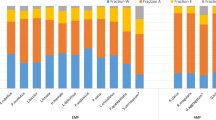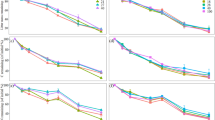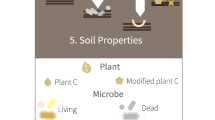Abstract
FORMATION of the mor type of forest litter, characterized by slow decomposition, has been attributed to a number of factors1–3, but the effect of mycorrhizal fungi, though postulated4,5, has not been studied experimentally. We have conducted an experiment in which root activity and thus mycorrhizal activity were reduced in small areas of an unthinned Pinus radiata stand. The following treatments (three replicates in a randomized block design) were applied to 1 × 1 m plots sited between the trees.
This is a preview of subscription content, access via your institution
Access options
Subscribe to this journal
Receive 51 print issues and online access
$199.00 per year
only $3.90 per issue
Buy this article
- Purchase on SpringerLink
- Instant access to full article PDF
Prices may be subject to local taxes which are calculated during checkout
Similar content being viewed by others
References
Handley, W. R., Forestry Commission Bull., No. 23 (1954).
Kononova, M. M., Soil Organic Matter (Pergamon, Oxford, 1966).
Kühnelt, W., Soil Biology (Faber and Faber, London, 1961).
Meyer, F. H., in Soil Micromorphology (edit. by Jongerius, A.), 23 (Elsevier, Amsterdam, 1964).
Mikola, P., in Mykorrhiza: Internationales Mykorrhizasymposium Weimar 1960, 277 (G. Fischer, Jena, 1963).
Lobanow, N. W., Mykotrophie der Holzpflanzen (VEB Deutscher Verlag der Wissenschaften, Berlin, 1960).
Author information
Authors and Affiliations
Rights and permissions
About this article
Cite this article
GADGIL, R., GADGIL, P. Mycorrhiza and Litter Decomposition. Nature 233, 133 (1971). https://doi.org/10.1038/233133a0
Received:
Revised:
Issue Date:
DOI: https://doi.org/10.1038/233133a0



